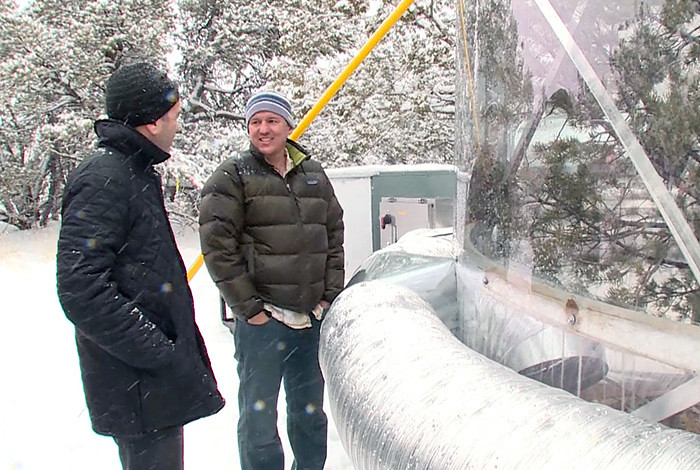Southwestern piñon forests likely to disappear by end of century

PBS NewsHour reporter Miles O’Brien (l) and Los Alamos scientist Nate McDowell discuss how climate change is killing trees.
A new study led by Los Alamos National Laboratory suggests that widespread loss of a major forest type, the pine-juniper woodlands of the Southwestern U.S., could be wiped out by the end of this century as a result of climate change and that conifers throughout much of the Northern Hemisphere may be on a similar trajectory. The new results suggest that global models may underestimate predictions of forest death.
“We have been uncertain about how big the risk of tree mortality was, but our ensemble of analyses—including experimental results, mechanistic regional models and more general global models—all show alarming rates of forest loss in coming decades,” said Los Alamos forest ecologist Nate McDowell. “Given the recent climate talks in Paris and their focus on protecting forests, especially from deforestation, our results provide extra incentive to protect forests from the warming itself, which requires reducing emissions.”
In addition to McDowell, the study included Los Alamos researchers Chonggang Xu, Turin Dickman, Sanna Sevanto and Jordan Muss and Park Williams (now at Columbia University) as well as collaborators from the University of New Mexico, the University at Buffalo, INRA-Bordeaux Sciences (France), Duke University, the U.S. Geological Survey, the National Center for Atmospheric Research, the University of Arizona, the University of Delaware and Lawrence Berkeley National Laboratory.
Climate change’s effects on trees
Trees, a precious carbon sink, become a carbon source when they die, so knowing how they interact with the climate and the carbon cycle is imperative to protecting the climate’s delicate balance.
The very mechanism that a tree uses to preserve its water stores during prolonged drought can be its undoing: the tree closes the stomata on its needles to prevent water loss, but this prevents the tree’s food source, carbon dioxide, from entering, halting photosynthesis. As the air becomes hotter and drier, subsequent pressure change pulls more water from the roots than can be supplied, and the water tension in the plant’s vascular system can become so great that the straw-like columns no longer support water flow. The hydraulic system can collapse or the tree undergoes the starvation process, and it subsequently becomes defenseless against bark beetles and disease since it can no longer secrete the thick resin that protects it. As the tree decays after death, the carbon stored in its tissues is released into the atmosphere as carbon dioxide.
The atmospheric demand for water is potentially the largest climate threat to survival, because increasing temperatures are driving a chronic increase in evaporative demand despite increases in humidity.
For more great science and technology stories from Los Alamos National Laboratory, check out our 1663 publication, which highlights the Laboratory’s most significant research initiatives and scientific accomplishments.
You also might enjoy the Laboratory’s Picture of the Week series, which offers compelling weekly images that reflect the institution’s multidisciplinary scientific and technological capabilities.
Community Connections features news and opportunities that grow out of the Laboratory’s Good Neighbor Pledge: “To partner with our neighbors on strengthening math and science learning, diversifying the economy and expanding community giving in northern New Mexico.”






